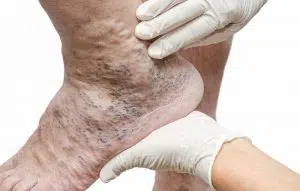Peripheral Artery Disease
What is Peripheral Artery Disease
Peripheral artery disease (PAD) is a condition that occurs when there is a buildup of plaque in the arteries that supply blood to the limbs, particularly the legs. This plaque buildup narrows and hardens the arteries, reducing blood flow to the legs and feet. PAD can cause symptoms such as leg pain, cramping, and fatigue when walking or exercising, which is called intermittent claudication. It can also cause skin discoloration, slow healing wounds, and even gangrene in severe cases.
PAD can be a sign of more widespread atherosclerosis, which is a buildup of plaque in the arteries throughout the body and can increase the risk of heart attack or stroke.
Risk factors for PAD include smoking, diabetes, high blood pressure, high cholesterol, obesity, a family history of PAD or cardiovascular disease, and aging. Treatment options for PAD include lifestyle modifications such as quitting smoking, exercise, and a healthy diet, medications to manage symptoms and underlying risk factors, and in severe cases, procedures such as angioplasty or bypass surgery to improve blood flow
What are the symptoms of Peripheral Artery Disease?
The symptoms of Peripheral Artery Disease (PAD) can vary depending on the severity of the condition. Some people may not experience any symptoms, while others may experience:
- Pain or cramping in the legs or hips while walking, climbing stairs, or exercising, which usually goes away with rest.
- Numbness, tingling, or weakness in the legs.
- Coldness in one or both feet.
- Changes in the color or texture of the skin on the legs or feet.
- Sores or ulcers on the legs or feet that are slow to heal.
- Weakness or fatigue in the legs, especially during physical activity.
- Erectile dysfunction in men.
- If you experience any of these symptoms, it is important to speak with your doctor. They can perform a physical examination and order tests to diagnose PAD and determine the best course of treatment. Early diagnosis and treatment of PAD can help prevent complications and improve your quality of life.
What Are the Treatments for Peripheral Artery Disease?
Treatment for Peripheral Artery Disease (PAD) aims to reduce symptoms, improve blood flow, and prevent complications. Depending on the severity of PAD, treatment options may include:
- Lifestyle changes: Making lifestyle changes such as quitting smoking, exercising regularly, eating a healthy diet, and managing underlying health conditions such as high blood pressure, high cholesterol, and diabetes can help manage symptoms and slow the progression of PAD.
- Medications: Medications such as antiplatelet agents, blood thinners, cholesterol-lowering drugs, and medications to manage high blood pressure and diabetes may be prescribed to improve blood flow and manage underlying health conditions.
- Angioplasty: A minimally invasive procedure in which a small balloon is inflated inside the narrowed artery to widen it and improve blood flow. A stent may be placed to help keep the artery open.
- Bypass surgery: In severe cases of PAD, a bypass surgery may be recommended. During this procedure, a surgeon creates a new path for blood to flow around the blocked or narrowed artery.
- Amputation: We are a Limb Salvage practice and will make every effort to avoid amputation. We would be happy to give an opinion even if you have been told an amputation is inevitable.
- Your doctor will work with you to determine the best course of treatment for your individual needs and symptoms. It is important to follow your doctor’s recommendations and attend regular follow-up appointments to monitor your condition and prevent complications.

